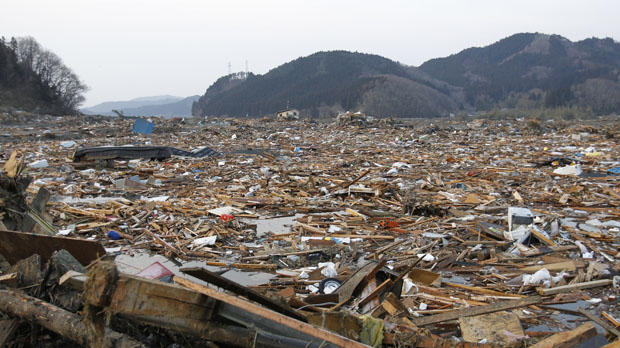After the tsunami – what next for Japan?
As rescue workers search the debris for survivors after Japan’s devastating tsunami, Ed Fraser looks back at the lessons learned from the aftermath of the Boxing Day tsunami of 2004.

The boats and ships washed miles inland into Japan, the sludge and the terrible stench of death are testament to the power of the tsunami.
The rescue workers are overwhelmed by a disaster the likes of which the world has never seen before – except it has.
On Boxing Day 2004, a massive sub-sea earthquake triggered a tsunami which engulfed vast swathes of Thailand, Indonesia and Sri Lanka. In total some 226,000 people in 13 Asian and African countries were killed – in many cases the bodies have never been found or identified.
‘Everything flattened’
Days later as my ITN news team travelled north along a motorway from Phuket, I was surprised there was little sign of the devastation. But an hour into our journey and still miles from the sea we passed a large fishing trawler discarded like a child’s toy in a field. It was the first of many we would find.
There was no sign of life – not even the birds were in evidence.
At Khao Lak we came across a temporary mortuary. A majestic temple where thousands of dead lay wrapped in individual white plastic bodybags – the industrialisation of death. Men, women, children and infants tagged and listed.
In the blistering heat the nauseating stench of decay felt like a physical presence. We wore paper masks to block it out in a futile gesture.
We drove on along a dirt track towards the sea expecting nothing could be more appalling.
Follow the latest events in Japan with our live blog
Around a corner we found what was left of the fishing port Ban Nam Khem where we lapsed into silence. Everywhere as far as the eye could see was flattened, pulverised by a force of water that had swept all before it in an instant. There was no sign of life – not even the birds were in evidence.
We surveyed a 360-degree catastrophe – ground zero of an apocalypse where the world had stopped. A once bustling centre of waterfront shops, restaurants and wooden homes obliterated. It seems that this could be the situation in Japan’s Minamisanriku, where up to 10,000 are missing and the town is almost destroyed.
Ban Nam Khem
Ban Nam Khem had been home to 5,000 and almost half had perished in what was now a mass grave.
Suvadee Sukkasem lost her four-year old son in Ban Nam Khem when the wall of water struck. His body, along with countless others, has never been found.
“So many people here are still looking for their family,” she later said.
So many people here are still looking for their family. Thailand tsunami survivor, Suvadee Sukkasem
Suvadee was washed out to sea floating for seven hours, holding her one-year old daughter in one arm while clinging to the wreckage of a broken boat before being rescued.
She said: “The village is scared of the sea, but we don’t know where to go. We live in new homes, but it is difficult. I don’t think I could ever leave knowing my son has never been found.”
In Pictures – Japan tsunami and earthquake photo gallery

Click on the image to see more photos from Japan
Recovery?
In the years since, Bill Clinton visited and new buildings sprang up – souvenir shops, a monument of the wave and a small museum with photographs of the tsunami recovery effort.
Between 6,000 and 8,000 people perished in Thailand’s tsunami, including over 2,000 foreign tourists.
In the weeks after, temporary mortuaries and photo galleries of the dead and missing would become the new reality.
The world’s biggest forensics investigation was launched after the Asian tsunami using DNA testing to identify the victims. It ended a few years ago.
Those who were recovered from Ban Nam Khem lie in graveyards near the beach in metal coffins surrounded by concrete chambers to preserve their DNA. But identification cannot be proved to internationally recognised protocols, preventing their return to their families. Their DNA is kept on file.
For the families of Japan, like Thailand, the next stage will be just as hard and they too will find that many of their dead may never be recovered or identified.
Ed Fraser is the editor of Channel 4 News online. He was in Thailand in the aftermath of the Boxing Day tsunami in 2004 for ITN.
Your browser does not support iframes. You could try and view the content directly